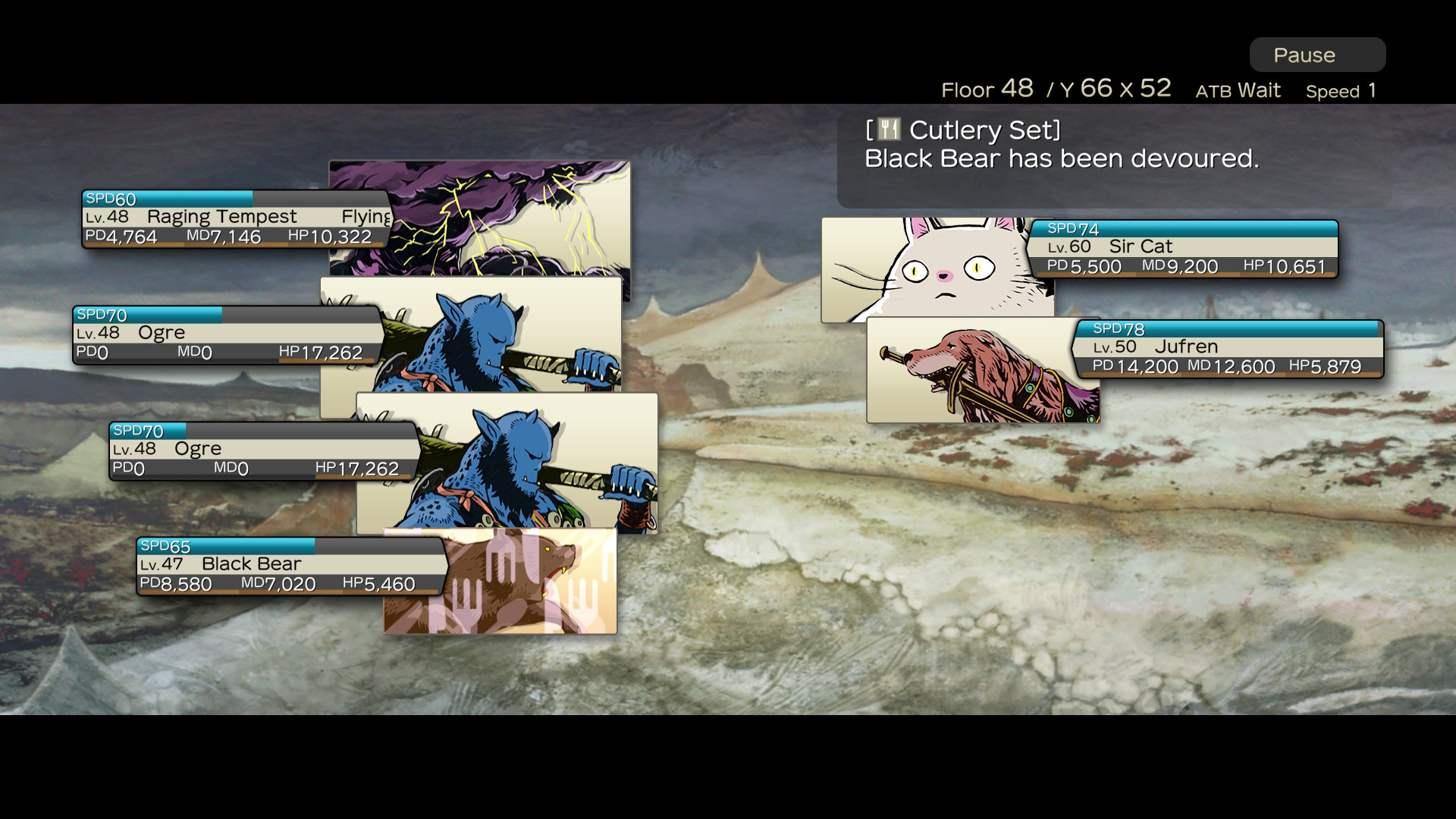Dungeon Encounters (PC)

I feel like I should hate this, but then I find myself playing it for 2 hour blocks at a time. I can’t tell if it’s actually any good, or it’s something that appeals just enough to the OCD in me to sucker me in.

If you’ve never heard of this game, it’s a barebones turn-based RPG. Every element in the game, the player characters, the battle and magic system, items and inventory, exploration, the artwork, the music, etc. is reduced to the bare essentials to make a complete game. I’m not going to bother to deep dive into the all of the little details to set up my thoughts, because every review ever already perfectly explains all of the details. There’s so little to explain it’s impossible they left anything out. So if you want a deeper explanation of everything, just go read a proper review.
Reviews keep saying that despite the simplicity it’s surprisingly complex! It’s not, really. Does an enemy have more magic or physical defense to start? Attack accordingly. Every party member can equip two attacks. You could, in theory, have a member with two melee attacks or two magic attacks, or one melee and one ranged. That would be incorrect and stupid, but you could do it. Instead, you’ll just equip everyone with one physical and one magic attack so that you can maximize damage by never needing one or more people to sit out a turn or split damage between magic and physical. You’ll also likely start prioritizing ranged weapons over melee weapons so everyone will always be able to do physical damage to flying creatures with low physical defense instead of wasting turns whittling down huge magic defense (see: damage maximization).
There’s no classes in the game, and no chance to even build specializations via stat points and the like. Everyone will always do the same damage with the same weapon or spell, there’s no modifiers.
By default, the game uses the Active Battle System so enemies will keep attacking if you’re sitting around trying to make decisions. Generally, enemies are deadly enough that you don’t want to fuck around and waste too much time because extra enemy turns will wipe your party, so it creates a need to act quickly. However, you can disable this in the options menu or disable this by just hitting the pause button.
There’s permanent status ailments that can’t be cleansed in or out of combat by any kind of spell or inventory item, and instead can only be cleansed by finding a specific friendly tile that can heal them. Some ailments incapacitate party members and remove them from your party until they’re healed. However, if you bother to explore you’ll find permanent immunities to every single one before they have a chance to become a problem.
Every black-numbered tile represents a group of monsters. You have a battle log that lists every number in the game and the potential monster make up of that tile. If you want, before you step on a monster tile, you can look up the group composition and then reequip your party accordingly. So far, up to floor 35, I just keep my party equipped with whatever weapons and spells create the biggest number.
Exploration consists of running over every tile in the floor, which also includes clearing every possible battle. You’ll pretty much want to clear every encounter so you don’t fall behind in leveling and because monsters can drop really useful upgrades. You’ll also want to clear every tile since clearing them on each floor rewards extra ability points that allow you to equip special abilities like healing spells, resurrection spells, and the aforementioned immunities. The overall benefit of clearing tiles so dramatically outweighs skipping them to get to the next floor sooner that there’s no real sense in not doing it (and once you get to floors 30-39 there’s literally no optional tiles).
So there’s this sort of illusion of depth and complexity but it all mostly still reduces down to the “hold down the attack button” level of gameplay that turn-based JRPGS have been criticized for since they were invented. In fairness I still have 60 floors to go, so maybe it somehow gets SUPER COMPLEX, but given the deliberate lack of combat options I suspect not. A lot of the potential challenge is optional. The active battle system can be ignored, you can optionally turn off displaying where monster tiles are located so you can blindly stumble upon them, and not clearing all tiles and monsters each floor is for min/maxing speed-runners on their 50th playthrough. Your healing and resurrection spells are limited to about 6 uses each, but healing and resurrection shrines with infinite uses are relatively common and eventually can become just a teleport spell away.
So why will I keep playing it and probably finish it? I don’t know. Slay the Spire is a better turn-based game by a mile with a better risk/reward “exploration” system. I would recommend that game over this any day. Maybe it’s because clearing a single floor is straightforward and doesn’t require a whole lot of time. Clearing a floor (I mean completely clearing) has such an obvious benefit to succeeding in the rest of the game that it doesn’t feel like a waste of time. So you can knock out a floor in 15 minutes during a break and feel like you’re actually making progress in the game instead of grinding a million random encounters or wandering some overworld getting nowhere. This would also probably count as a “chill game.” If you need something to mindlessly plow through that checks all the boxes of what a game is, then here you go. Maybe. It’s $30, so maybe wait until it’s on sale.
I guess I can also pretentiously appreciate it as kind of an educational guide on JRPG game design for amateurs. It strips away all the bullshit so you’re left with nothing but a game board and game pieces and a minimal set of rules for how they interact. Additionally, everything in the game serves an actual functional purpose. Physical and magic attacks have direct and obvious uses in combat and you will most definitely use both through the end of the game. Exploring every tile isn’t there to check off some 100% achievement (although there is a log of completion percentage of every floor), it is basically vital to success. Equipment and items have clear and obvious benefits to survival. Etc. In other words, every part of the game actually justifies its existence instead of padding things out or being some vestigial idea that should have been cut.
Comments? Join us on the forum.
![]() Rafiki
Rafiki





